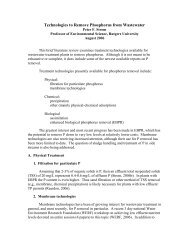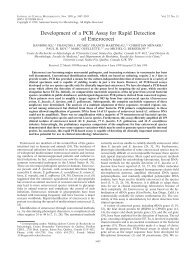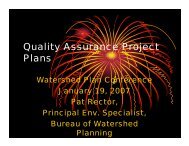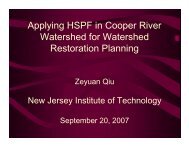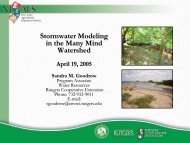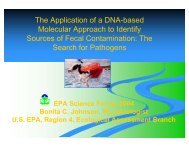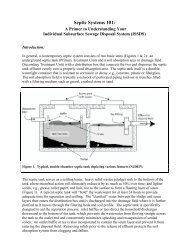Onsite Wastewater Treatment Systems: Alternative Technologies
Onsite Wastewater Treatment Systems: Alternative Technologies
Onsite Wastewater Treatment Systems: Alternative Technologies
Create successful ePaper yourself
Turn your PDF publications into a flip-book with our unique Google optimized e-Paper software.
Advantages: Efficient removal of nitrate, phosphorus,and ammonia.Disadvantages: This technology requires professionaloperation and maintenance, so a contract with a licensedcompany is highly recommended.Purchase Cost: The cost of equipment and installation isabout $8,500 to $12,000Operation and Maintenance Cost: Yearly maintenancecosts are on average $250 to $400. This includes electricity,inspections, and pumping.Soil Absorption <strong>Systems</strong>1. Mound SystemMound systems (Figure 6) are so prevalent they are notconsidered an “alternative” technology. They are appropriatefor areas with a high water table or shallow bedrock.A septic tank or alternative system first treats the wastewater.The liquid then flows into a storage compartment,where it is pumped up to a leach field within a soil mounda few feet above grade. The mound provides an adequatevolume of unsaturated soil to treat the wastewater thatexits the perforated pipe network in the leach field. Thecost of a mound system is highly variable, depending inlarge part on the cost of the transport of the appropriatesoil mixture to the construction site.<strong>Wastewater</strong>From HouseSeptic TankSoil AbsorptionPipe NetworkDosing Tank andHydraulic PumpVegetation(Grass)Sand MoundFigure 6. Mound System Schematic (Schematic courtesy ofDavid Berry)Advantages: The mound system performs well in areaswith high water tables or shallow bedrock.Disadvantages: Installation is expensive and the moundcan be visually and physically obtrusive.Purchase Cost: A mound system costs approximately$25,000 to install.Operation and Maintenance Cost: About $100 per year.This cost includes electricity and regular inspections.2. Subsurface Drip SystemDrip systems (Figure 7) feature small diameter plastic pipingwith effluent emitters. The piping network runs througha system of shallow trenches. Effluent is pumped intermittentlyto the pipes for slow infiltration into the soil.<strong>Wastewater</strong>From HouseFigure 7. Drip System Schematic (Schematic courtesy ofDavid Berry)Advantages: Drip irrigation is ideal in hilly, rocky conditionswhere there is little space for soil absorption. Italso avoids mound necessity.Disadvantages: It is important that the effluent has beenfiltered of solids that could potentially clog the piping.The effluent should be treated to an advanced level so thatit is safe for shallow land application.Purchase Cost: Approximately $15,000 including thepumps, valves, and control units.Operation and Maintenance Cost: The annual fee foran operation and maintenance contract is approximately$500. This covers inspections and regular maintenance.Electricity usage will add a small additional cost.3. Peat FieldSeptic TankAdvanced<strong>Treatment</strong>Dosing Tank andHydraulic PumpSubsurface Small DiameterDrip Infiltration SystemA peat leach field, which is usually in a contained unit, isvery similar in design to a conventional leach field. Themain difference is that effluent drips through a layer ofpeat before entering the soil. This has been shown toimprove the quality of effluent by reducing total solidsand nitrate levels. Because peat is a natural substance, thecomposition of it is extremely variable. Peat that is to beused for onsite treatment must have certain characteristicsto make it an efficient filter, such as proper moisturecontent and preparation.Advantages: Peat is relatively simple to install andmaintain, and delivers a high quality effluent.Disadvantages: It is important that the system be builtcorrectly and with the right materials because if improperlyinstalled peat systems may clog.Purchase Cost: Installation of the peat field is approximately$10,000.3



